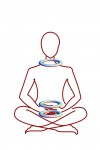Articles
Understanding Pelvic Tilt
The pelvis has three primary skeletal components: the right hip, the left hip, and the sacrum. While these pieces can move independently, they often work together as a unit, and the each piece exerts an influence on the pelvis as a whole. They will be discussed collectively in this article. Pelvic tilt involves a simultaneous movement of both hips, the sacrum, and the lumbar vertebrae. (Read more…)
I recently received a question regarding the timing of moon days, which got me thinking. (What follows is simply my conjecture & curiosity, I am not an expert.)
Q: If a full or new moon occurs before sunrise, should it be observed on the previous day?
For example, if the new moon is at 4:29am on Wednesday, should the Ashtangi take off practice on Tuesday?

This transliteration is written phonetically for ease of learning. It is broken up by syllable for easy pronunciation. The IAST transliteration, along with the Sanskrit and full translation, is below.
Om
vande gurunam charanara vindesan … (read more…)
I said something soothing in response. That wasn’t the first time that class she had said something of the sort. It wasn’t until later that I found the words I really wanted: “Why are you apologizing to me? I’m here to serve you, no matter if you’re athletic or stiff or crippled fro … (read more…)

Much allure surrounds the Bandha, though they tend to be poorly understood and under-explained. This is my experience of the Bandha, an account of a living practice rather than a technical or philosophical perspective. The Bandha are not something to be understood solely by reading Hatha Yoga … (read more…)
